Muslim Americans are a diverse and growing population, currently estimated at 3.45 million people of all ages, including 2.15 million adults (see below for an explanation of this estimate). The U.S. Muslim community is made up heavily of immigrants and the children of immigrants from around the world. On average, Muslim Americans are considerably younger than the overall U.S. population. 7
In their educational attainment levels, Muslims closely resemble the general public. About three-in-ten (31%) U.S. Muslims are college graduates, including 11% who have a postgraduate degree. On average, Muslim immigrants are more highly educated than U.S.-born Muslims.
Financially, Muslims are about as likely as Americans in general to have a household income over $100,000. At the same time, they are more likely than Americans in general to have an income under $30,000. The survey also finds that Muslims are three times as likely as other Americans to be without a job and looking for work.
The rest of this chapter provides a detailed examination of the demographic characteristics of the U.S. Muslim population.
Three-quarters of U.S. Muslims are immigrants or the children of immigrants

Nearly six-in-ten U.S. Muslims adults (58%) are first-generation Americans, having been born in another country. An additional 18% are second-generation Americans – people who were born in the U.S. and who have at least one parent who was an immigrant. About a quarter (24%) of U.S. Muslims are U.S. natives with U.S.-born parents (i.e., they are from families who have been in the U.S. for three generations or longer), which is the case for nearly three-quarters of U.S. adults overall (73%).
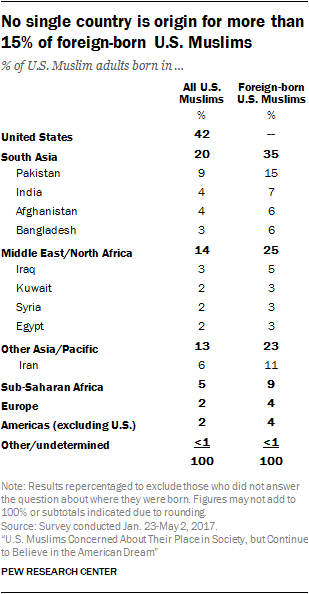
Among U.S. Muslim adults who were born abroad, more come from South Asia (35%) than any other region. An additional 23% were born in other parts of the Asia-Pacific region (such as Iran, Indonesia, etc.); 25% come from the Middle East-North Africa region, 9% come from sub-Saharan Africa, 4% were born in Europe and 4% come from elsewhere in the Americas.
No single country accounts for more than 15% of adult Muslim immigrants to the United States (15% are from Pakistan).8 The countries with the next-highest totals are Iran (11% of Muslim immigrants), India (7%), Afghanistan (6%), Bangladesh (6%), Iraq (5%), Kuwait (3%), Syria (3%) and Egypt (3%).
The geographic origins of Muslim immigrants in the United States do not precisely mirror the global distribution of Muslims (though most U.S. Muslim immigrants are from Asia, which is also home to most of the world’s Muslims). For more details about the geographic distribution of the worldwide Muslim population, see Pew Research Center’s April 2017 report “The Changing Global Religious Landscape.”
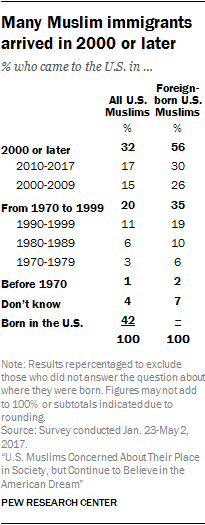
Three-in-ten Muslim immigrants have arrived in the U.S. since 2010. An additional 26% arrived between 2000 and 2009, and roughly one-in-five (19%) Muslim immigrants arrived in the 1990s. One-in-ten immigrated in the 1980s, 6% arrived in the 1970s and just 2% of Muslim immigrants say they arrived in the U.S. before 1970.
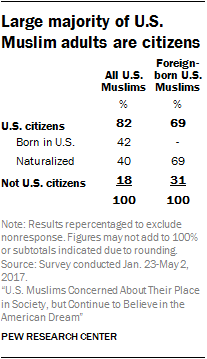
The survey also finds that the vast majority of Muslims living in the U.S. (82%) are American citizens, including 42% who were born in the U.S. and 40% who were born abroad but who have naturalized. The remainder are not U.S. citizens (18%).
Looked at another way, 69% of all foreign-born U.S. Muslim adults have become naturalized U.S. citizens.
Muslim Americans are racially and ethnically diverse
No racial or ethnic group makes up a majority of Muslim American adults. A plurality (41%) are white, a category that includes those who describe their race as Arab, Middle Eastern, Persian/Iranian or in a variety of other ways (see sidebar on white racial classifications). About three-in-ten are Asian (28%), including those from South Asia, and one-fifth are black (20%).9 Fewer are Hispanic (8%), and an additional 3% identify with another race or with multiple races.
Muslim immigrants are much more likely than U.S.-born Muslims to describe their race as Asian (41% vs. 10%). And U.S.-born Muslims are more likely than immigrant Muslims to be black (32% vs. 11%). In fact, fully half of Muslims whose families have been in the U.S. for at least three generations are black (51%).
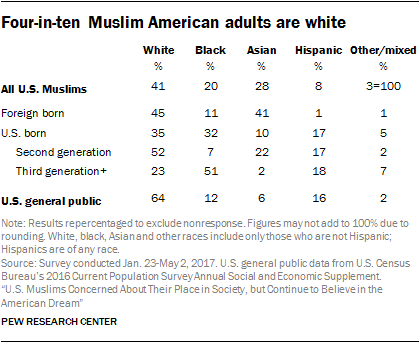
Racial classifications and Muslim Americans
This survey uses the following set of racial and ethnic classifications: white, black, Asian, Hispanic, multiracial and other. These classifications are based largely on current Census Bureau categories, as is generally true of Pew Research Center work. However, it is sometimes difficult for respondents to select from the Census Bureau’s options. For example, immigrants and the children of immigrants from the Middle East-North Africa region and from Iran have no explicit option to identify as Arab, Persian, Kurdish, etc., or to identify with a particular place of origin (e.g., Egypt, Palestine, Morocco) in place of a racial category. In the census, respondents who specify a country or region of origin in the Middle East-North Africa region instead of a specific racial category generally are counted as white; historically, the U.S. government has classified people as white if they have “origins in any of the original peoples of Europe, the Middle East or North Africa.”10
This may soon change. In recent years, advocacy groups for Arab Americans and others have argued that being classified as white does not reflect the self identity of Americans from the Middle East or North Africa.11 In response, the U.S. Census Bureau is considering a new “MENA” category for people from the Middle East and North Africa for possible use in the 2020 census and census surveys.12
At present, however, Pew Research Center generally uses the census classifications because they allow comparisons with the general public both for statistical analysis and, in some cases, for weighting of survey data to achieve nationally representative samples. (For more detail on weighting procedures, see the Methodology.) In this survey, nearly nine-in-ten immigrants from the Middle East-North Africa region (87%) are counted as white, including those who volunteered their race as “Arab” or “Middle Eastern,” those who identified with a specific country instead of a race, and those who explicitly identified themselves as white. In total, U.S. Muslim respondents were more likely to be counted as white (41%) than any other listed race option.
The historic connections between Arabs and “whiteness,” in the American context, date to the early 20th century, when being white – or, more precisely, being classified as white by the U.S. government – was important for immigrants who wanted to become citizens.13 Scholars of Arab American history highlight the significance of a 1915 U.S. appellate court ruling that granted citizenship to a Syrian man on the grounds that he was white.14 The court decisions allowed many Arab immigrants from West Asia to avoid being racially classified as Asian, which would have hurt their chances at immigration or naturalization.15
A closer look at U.S.-born black Muslims
American-born black Muslims stand out from other U.S. Muslims in several ways, according to the survey: Fully two-thirds are converts to Islam, compared with just one-in-seven among all other U.S. Muslims. And while they are about as likely as other Muslims to say they are proud to be American, U.S.-born black Muslims are less likely than other U.S.-born Muslims to say they have a lot in common with most Americans, and they are more likely than all other U.S. Muslims to say natural conflict exists between the teachings of Islam and democracy.
In addition, American-born black Muslims are more likely than other U.S. Muslims to say it has become harder in recent years to be Muslim in the United States. Nearly all American-born black Muslims (96%) say there is a lot of discrimination against Muslims in America, almost identical to the share who say there is a lot of discrimination against black people in the U.S. (94%).
African American Muslims have long played a notable role in U.S. Muslim society. However, as immigrant populations from Muslim-majority countries in the Middle East and Asia have grown, African American Muslims have decreased as a share of the U.S. Muslim population.16 The new survey finds that American-born black people account for about 13% of the adult Muslim community.17 And among Muslims whose families have been in the U.S. for at least three generations, fully half are black. Another 6% of all adult Muslims identify as black, but were born outside the U.S., generally in sub-Saharan Africa.
Muslim American population is much younger than U.S. adults overall
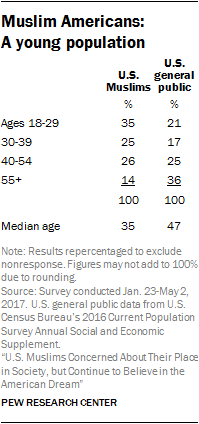
The American Muslim adult population is considerably younger than the overall U.S. adult population. About a third (35%) of Muslim American adults are between 18 and 29 years old, which is a far higher percentage than the share of the general population that falls in that age bracket (21%).
Similarly, adults ages 18 to 39 make up 60% of the Muslim American adult population, compared with 38% of the U.S. adult population as a whole. Meanwhile, at the other end of the age spectrum, adults ages 55 and over make up just 14% of Muslim Americans, while people in this older age bracket comprise 36% of the overall U.S. adult population.
Another way to compare how old or young a group is within a broader population is to calculate its median age, which for Muslim adults in the U.S. is 35. In the U.S. population as a whole, the median age of adults is 47.
About half of Muslim Americans are married
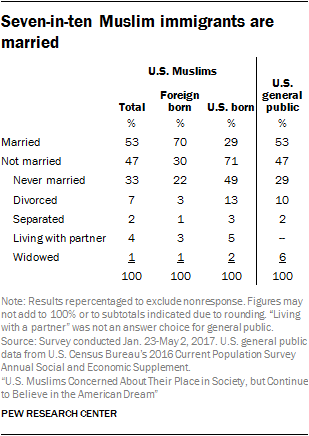
Roughly half (53%) of Muslim adults in the U.S. are married. A third (33%) have never been married, while 8% are divorced or separated, 4% are unmarried but living with a partner, and 1% are widowed. Foreign-born Muslims are much more likely to be married than are Muslims who were born in the U.S. (70% vs. 29%).
The vast majority of U.S. Muslims who are married have a spouse who is also Muslim. For details, see here.
The share of Muslim American adults who are married is identical to the share of U.S. adults overall who are married (53%), even though Muslims are younger than the U.S. general public.
Muslim Americans have 2.4 children, on average
The survey results indicate that among adults ages 40 to 59, Muslim Americans report having an average of 2.4 children over the course of their lives. Americans overall average 2.1 children.18 This is in line with previous Pew Research Center research suggesting that, worldwide, Muslims have higher fertility rates than any other major religious group.
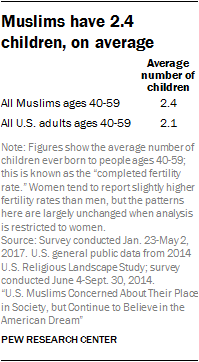
Muslims have similar levels of education to Americans overall, but report lower incomes
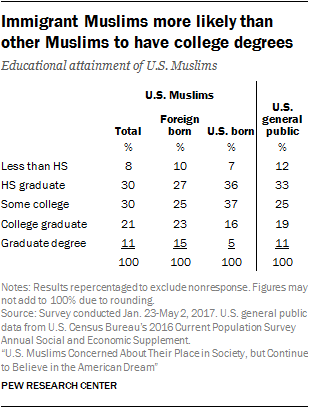
About three-in-ten U.S. Muslims (31%) have college or postgraduate degrees, equivalent to the share among U.S. adults as a whole (31%). Foreign-born Muslims are more likely to have at least a college degree (38%) than are Muslims born in the U.S. (21%), perhaps reflecting immigration policies that give preference to highly educated immigrants.
Similarly, U.S. Muslims are about as likely as Americans overall to report household incomes of $100,000 or higher (24% of Muslims and 23% of Americans in general). But they also are more likely to be at the other end of the income scale: 40% of Muslim Americans report household incomes under $30,000, compared with 32% of the U.S. population as a whole. Muslims are also less likely than the general public to fall into the middle range, between $30,000 and $99,999 – 35% of Muslims report household income in this range, compared with 45% of all Americans.
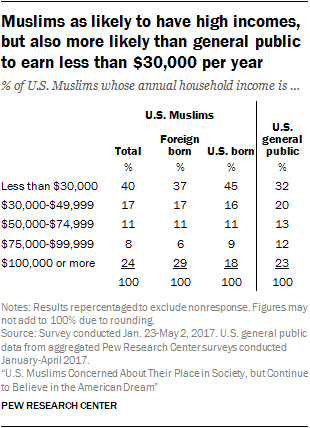
The share of Muslims who report owning a home (37%) is considerably lower than among all U.S. adults (57%).
Fewer than half of Muslim adults say they are employed full time (44%). Overall, 29% of Muslims are underemployed, in that they are either employed part time but would prefer full-time work (10%), or they are not employed but they are looking for work (18%). By comparison, 12% of U.S. adults overall are underemployed in these ways, according to a 2016 Pew Research Center survey.
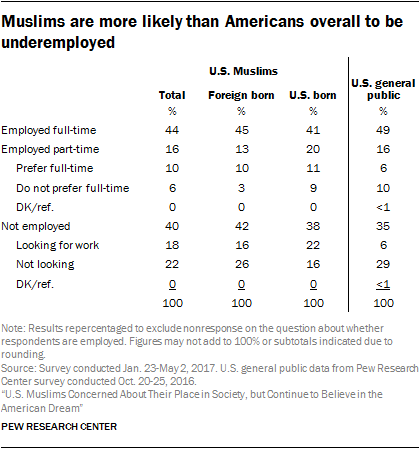
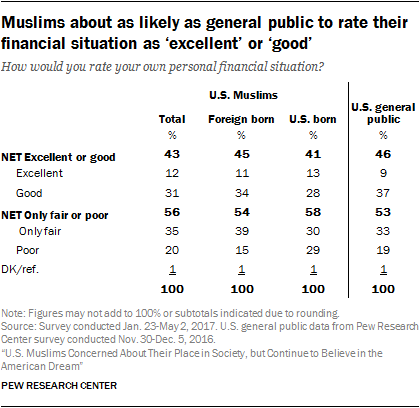
Still, Muslims are about as satisfied with their finances as are U.S. adults as whole. Asked to rate their personal financial situation, 43% of Muslims say they are in either “good” or “excellent” financial shape, while 56% say they are in “only fair” or “poor” shape financially. Among the general public, 46% rate their financial situation as good or excellent, while 53% say it is only fair or poor.
Most Muslims live in households with other people who are all Muslim
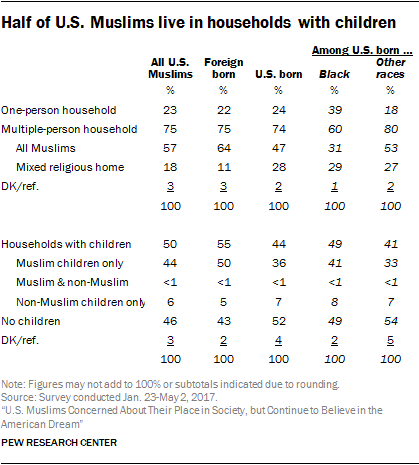
The most common living situation among Muslim Americans – especially immigrants – is a multi-person household in which everyone is Muslim. More than half of Muslims (57%) live this way. An additional 18% of Muslims live in a home with non-Muslims (such as a non-Muslim spouse), while 23% live alone.
Half of Muslim Americans live in a household with minor children, and usually those children are Muslim. But 6% of all U.S. Muslims live in households with children who are not Muslim.
How many Muslims are there in the United States? And how do we know?
There are no U.S. government statistics on the number of Muslim Americans. For that matter, there are no official figures on the size of any religious group in the U.S., because the Census Bureau does not collect information on the religious identification of residents. With surveys like this one, however, demographers can calculate a rough estimate of the number of Muslims who currently reside in the country.
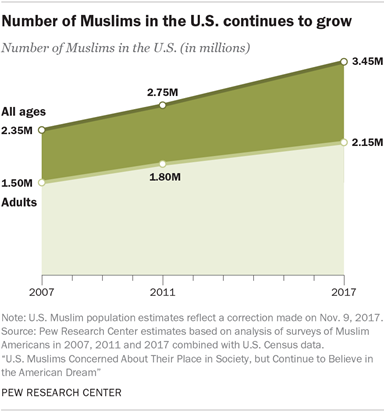
Based on these calculations, Pew Research Center estimates that there are currently 3.45 million Muslims in the U.S., including 2.15 million adults and 1.35 million children. Muslims account for roughly 1.1% of the total U.S. population (including both adults and children), as well as approximately 0.9% of the U.S. adult population.19
Moreover, the U.S. Muslim population has been growing rapidly, albeit from a relatively low base. When the Center first conducted a study of U.S. Muslims in 2007, researchers estimated that there were 2.35 million Muslims of all ages (including 1.5 million adults). By 2011, the number of Muslims had grown to 2.75 million (including 1.8 million adults). Since then, the Muslim population has continued to grow at a rate of roughly 100,000 people per year, driven both by natural increases due to fertility and by migration of Muslims to the U.S.
These estimates are derived through a multistep process that combines information from the survey on the prevalence of Muslims among immigrants and other demographic groups with official Census Bureau statistics on the total number of people in the U.S. who fall into these groups.
In the first step of this process, every country in the world is sorted into one of five categories (very high, high, medium, low or very low) based on the percentage of U.S. immigrants from that country who identify as Muslim. For instance, a large majority of the survey respondents who were born in Pakistan say they are Muslims, and therefore Pakistan is included in the “very high” category; the survey indicates that, on average, about two-thirds of U.S. adults from the “very high” countries are Muslim. The “high” category includes countries such as Afghanistan, Egypt and Jordan, among others; altogether, roughly one-third of respondents born in these countries are Muslim. At the other end of the spectrum, none of the survey respondents who were born in Mexico say they are Muslim, and thus Mexico is included among countries in the “very low” category; the survey indicates that, on average, just one-half of one percent (0.5%) of U.S. residents who were born in the “very low” countries are Muslim.
In the second step of the process, these survey-based estimates are combined with official Census Bureau information about the country of birth of all U.S. residents.20 Census data show, for instance, that there are currently about 300,000 households in which either the head of the household or the spouse is an immigrant from one of the countries in the “very high” category. Combining the survey finding that, on average, 68% of immigrants from countries in the “very high” category are Muslims with the Census Bureau data yields an estimate that there are roughly 200,000 U.S. households headed by Muslims born in countries in the “very high” category; these households include about 400,000 Muslim adults and 225,000 Muslim children.21
In the third step of the process, this procedure was repeated for immigrants from countries in each of the other categories (high, medium, low, very low), as well as for households in which either the head or spouse is a U.S.-born adult with at least one foreign-born parent.
Finally, U.S.-born adults whose parents were also born in the United States were subdivided by age and race (e.g., blacks under age 40, blacks ages 40 and older, etc.), and the process was repeated again for each of these groups. For example, the survey estimates that Muslims account for 2.1% of all black adults under age 40 whose families have been in the U.S. for three generations or longer. Census data indicate that there are about 4.65 million households headed by African Americans under age 40. Combining this figure with the survey data produces an estimated 100,000 households where the head or spouse is a third-generation (or higher) African-American Muslim under 40; these households include about 125,000 Muslim adults and 125,000 Muslim children.22
After obtaining estimates of the number of Muslims in each subgroup of the population – including immigrants categorized by country of origin and the U.S.-born categorized by age and race – the figures were summed to generate an estimate of the overall size of the Muslim population.
This detailed approach to estimating the size of the Muslim population has several advantages. Perhaps most importantly, research shows that it is easier to reach and survey U.S.-born adults than it is to reach and survey immigrants, especially immigrants who may face a language barrier. Using official statistics from the Census Bureau in the way described above helps ensure that Muslims are not undercounted simply because they were born in countries like Bangladesh or Somalia (for example) and may, therefore, be difficult to reach.
Of course, the approach outlined above is not the only possible method for estimating the size of the U.S. Muslim population. One alternative is to estimate the percentage of Muslims in the overall U.S. population directly from the results of a survey, without combining the survey data with census figures. Estimates based directly on survey incidence rates tend to be very similar to the estimates described above. For example, Pew Research Center’s 2014 Religious Landscape Study found that Muslims accounted for 0.9% of the U.S. adult population in that year. Aggregated political surveys conducted by Pew Research Center since the beginning of 2016 find that 1.1% of U.S. adults are Muslims. And, over the last decade, estimates of the Muslim share of the population produced by the General Social Survey (GSS) have ranged from 0.4% to 1.1%.23
The estimate that there are now 3.45 million Muslims in the United States is also consistent with demographic projections outlined in Pew Research Center’s report “The Future of World Religions: Population Growth Projections, 2010-2050.” In that report, demographers compiled data from nearly every country in the world on the current size of religious groups, the age structure and fertility rates of those groups, their rates of religious switching and migration, and related information to produce country-by-country projections of the future growth trajectories of religious groups from 2010 to the year 2050. Those analyses projected that the number of U.S. Muslims (of all ages) would reach 3.3 million by 2015 and 3.85 million by 2020.
Still another way to estimate the size of the Muslim population was employed by Ihsan Bagby in his study “The American Mosque 2011,” which was based on an extensive survey conducted among leaders of a large sample of mosques around the country.24 In that study, estimates of the average number of people associated with a mosque were combined with information on the total number of mosques in the United States to produce an estimate that there are 2.6 million mosque-connected U.S. Muslims (i.e., Muslims who attend mosque at least once or twice a year for Eid prayers). In the current Pew Research Center study, 74% of U.S. Muslims say they attend mosque a few times a year, especially for Eid prayer; when combined with the Center’s demographic estimate that there are 3.45 million Muslims of all ages in the U.S., this suggests that there are 2.6 million mosque-connected U.S. Muslims, a figure very similar to the estimate from “The American Mosque 2011.”25




